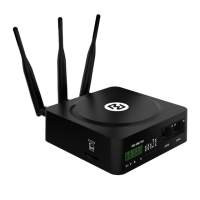Robustel R1510 User Guide
RT_UG_R1510_v.1.0.1 Dec. 31, 2019 53/140
General Settings @ Access Point
Enter the Service Set Identifier, the name of your
wireless network. The SSID of a client and the SSID of
the AP must be identical for the client and AP to be able
to communicate with each other. Enter 1 to 32
characters.
Click the toggle button to enable/disable the SSID being
broadcast. When enabled, the client can scan your
SSID. When disabled, the client cannot scan your SSID.
If you want to connect to the router AP, you need to
manually enter the SSID of router AP at WiFi client side.
Select from “Disabled”, “WPA-Personal”,
“WPA-Enterprise”, or “WEP”.
Disabled: User can access the WiFi without
password
Note: It is strongly recommended for security
purposes that you do not choose this kind of
mode.
WPA-personal: WiFi access protection, only one
password is provided for identity authentication
WPA- enterprise: Using RADIUS service for Wi Fi
security network protection
WEP: Wired Equivalent Privacy provides encryption
for wireless device’s data transmission
Select from “Auto”, “WPA” or “WPA2”.
Auto: Router will choose automatically the most
suitable WPA version
WPA2 is a stronger security feature than WPA
Select from “TKIP” or “AES”.
TKIP: Temporal Key Integrity Protocol (TKIP)
encryption uses a wireless connection. TKIP
encryption can be used for WPA-PSK and WPA
802.1x authentication
AES: AES encryption uses a wireless connection.
AES can be used for CCMP WPA-PSK and WPA
802.1x authentication. AES is a stronger encryption
algorithm than TKIP
Note: The security mode will affect wireless
communication rate. Different wireless modes support
different encryption modes. For example, 802.11n
supports neither WEP security mode nor TKIP
algorithm. If they are used, the wireless communication
rate will reduce to 54Mbps (802.11g mode). It is
recommended to select AES in 802.11n mode.

